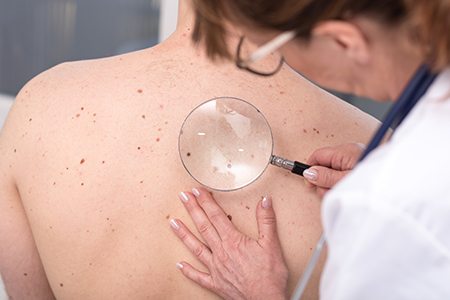 With most of the United States experiencing warmer weather, increased sun exposure can lead to an increased risk of developing skin cancer. There are more new cases of skin cancer in the US each year than breast, prostate, lung, and colon cancers combined.
With most of the United States experiencing warmer weather, increased sun exposure can lead to an increased risk of developing skin cancer. There are more new cases of skin cancer in the US each year than breast, prostate, lung, and colon cancers combined. The most dangerous form of skin cancer is melanoma, which if left untreated can metastasize to other locations within the body1.
Detecting Skin Cancer by Self-Examination
There are multiple forms of skin cancer, generally detectable by evaluating skin spots with this ABCDE rubric:- Asymmetric (Is the spot circular or elongated?)
- Borders (What do the edges of the spot look like?)
- Color (Does the spot have multiple colors, has the color changed, or is it very dark?)
- Diameter (Is the spot greater than 6 mm wide?)
- Evolving (Has the spot changed in size or shape?)
Preventing Skin Cancer
Luckily, preventing skin cancer is easy! Roughly 90% of non-melanoma skin cancers and 85% of melanomas are associated with UVA and/or UVB exposure, which can be effectively prevented by sunscreen with an SPF higher than 15 and sun-blocking clothing.Experts recommend that a sunscreen protecting against both of these types of radiation should be worn daily. If extended outdoor activity is planned, then a higher SPF water-resistant sunscreen should be applied as well.
It is important to note that water-resistant sunscreen is not waterproof and should be reapplied every two hours when swimming or if excessively sweating.
More Tips for Reducing Skin Cancer Risk
In addition to sunscreen, there are additional preventative measures one can take to decrease the chances of developing cancerous growths, as recommended by the Skin Cancer Foundation2:- Stay in the shade during the sunniest parts of the day (10 AM - 4 PM)
- Do not allow your skin to get sunburned
- Never use UV tanning beds
- Utilize UV-blocking glasses and hats to prevent sun exposure to the eyes and face
- Keep newborns out of the sun entirely
- Examine your skin from head-to-toe every month
- Visit a dermatologist for a full-body exam once a year
















.jpg)

.jpg)
.jpg)
.jpg)
.jpg)





.jpg)


.jpg)
.jpg)




.jpg)




.jpg)

.jpg)



